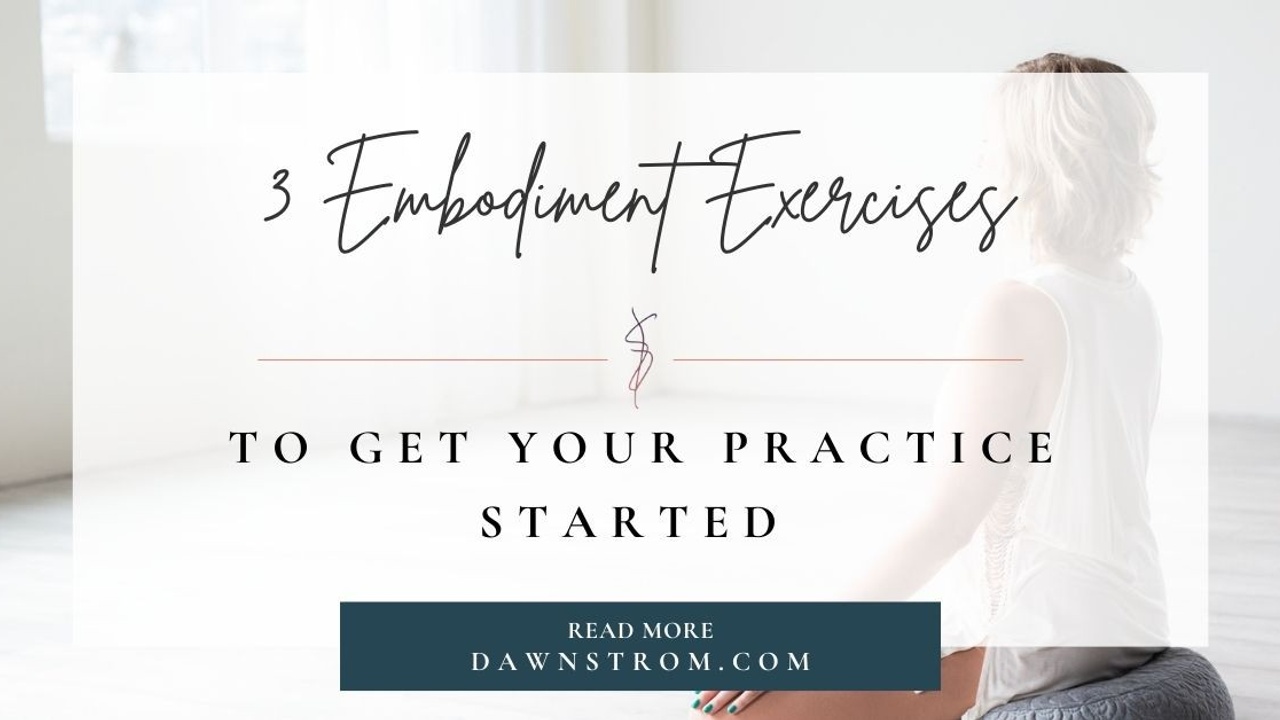
3 Embodiment Exercises to Start Your Self-Care Practice
Mar 07, 2021
Hey there, it’s Dawn.
I’m back to talking a little bit more about embodiment tools and the three embodiment pillars that are foundational to my view of embodiment.
The three pillars of my approach to embodiment are:
1) Grounding into your body
2) Focusing on breathing
3) Using intentional movement
To help you understand how these pillars work together, I want to do a simple exercise that brings them into focus. The first thing you want to do is find a place to sit where you can ground your feet down into the floor, so you want to feel like you can sit upright on the edge of your stool, and I’m going to have you close your eyes. I’m going to keep mine open, but go ahead and close them, and I’m just going to lead you through a short body scan. With this awareness, we’re going to do a little breathing, and then I’m going to do a little movement.
Let’s start with the first piece. Go ahead and close your eyes and sit on your stool with your feet flat on the ground. I want you to notice and bring your awareness into your body and start to sense where you are in space. This practice is called a simple body scan. Start by bringing your awareness down to your feet. I want you to feel your feet on the floor and then go ahead and trace up your body with your inner eye.
Take your awareness all the way up through your legs and feel the upper bones of your legs connecting up into your hip sockets. Then go ahead and trace up through your spine and across your chest and down through your arms. You have a sense of your arms just hanging at your sides. Just notice if your body wants to make any adjustments as you bring awareness to it, so you may feel like you’re slumping a little bit. You want to find a little easier, more upright alignment, so make whatever adjustments, bring your body into more of a sense of ease, and an arrangement where you feel like you can take a deep breath.
In the second piece, we’re going to go right into that breathing. So bring your hands to your belly actually and take a few deep inhales and exhales. With the inhale and exhale, for the first couple of times, I want you to notice where you’re breathing. Notice if you feel like you’re holding your breath in one area of your body or another or if you feel like you can take a deep breath all the way down into your abdomen. You feel like your abdomen area can expand with the inhale and contract with the exhale. If you feel like you’re holding your breath in your shoulders and your breathing is shallow, try to drop and relax your shoulders and bring your awareness down to your belly, so you feel a sense of filling in your abdomen as well as you inhale. Just see if you can start to deepen that breath.
We’re going to do a couple more breaths, and you will focus on the expansion and contraction of the breath. As you inhale, let your body expand. As you exhale, keep exhaling until you have fully emptied out your lungs, and you feel a deep contraction of the lungs. That exhale is going to help to stimulate your parasympathetic nervous system and bring you into a more profound sense of rest and restoration.
To add one last little piece to this- intentional movement. Go ahead and open your eyes. And all we’re going to do is just a simple spiral. So we want to connect that awareness of our breathing and our upright spine, and we’re just going to do a little twist side to side. You will inhale as you twist and exhale as you come back to the center. Using your eyes to look behind you will bring our vision into play and help you integrate your body awareness and your breathing as a foundation for movement,
After you have done a few spirals, close your eyes again, and I want you just to check back in, do a quick little body scan again, and notice if you feel any difference in your body. Do you feel more upright? Do you feel sensations in areas that you may not have felt feeling before? Just notice how you feel. Notice if you’re breathing any more deeply and if you’re more aware of yourself in space. And then open your eyes to finish the exercise.
That’s just a simple way to look at those three layers of the embodiment process. The grounding into your body brings you into sensing your body. The breathing piece starts to bring you into the movement of your body. And the intentional movement piece helps you to connect and use your awareness and your breathing to support the intentional movement of your body.
Embodiment is a tool for health and well-being. Intentional movement can help you avoid injury, prevent injury and help you feel great daily, but it also helps you to get into your body and feel empowered in how you’re moving and intentionally being in your body on a daily basis.
All the best,
Dawn






